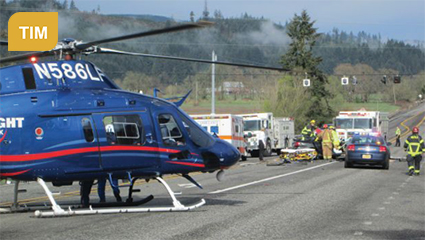Using Capability Maturity Frameworks for Transportation System Management and Operations (TSMO) Program Advancement:
Case Studies and Lessons Learned
Chapter 1. Introduction
This report is intended for transportation professionals who work at State and local agencies and provides evidence on how capability maturity assessments can help accelerate the evolution of Transportation Systems Management and Operations (TSMO) programs. Through the real-world examples that are provided, agencies will gain confidence in the utility of these frameworks to help meet their local program needs.
State and local departments of transportation (DOTs) are slowly moving toward a greater emphasis on managing their transportation systems to support travel mobility and reliability. These agencies, often under the umbrella of the TSMO program, seek to maximize the efficiency of their transportation systems by using an integrated suite of strategies that work together to preserve the roadway capacity and improve safety, security, and travel reliability.
Over the last two decades, TSMO deployment has advanced significantly. TSMO now encompasses a diverse set of activities that include approaches to manage both recurring and non-recurring sources of congestion. Today, these include activities such as traffic incident management, work zone management, traffic signal management, traveler information, road weather management, and corridor management. More importantly, applications and strategies under the TSMO umbrella are steadily taking advantage of developments in traffic technology, connectivity, and understanding of travel behavior.
While the growth of TSMO has been impressive, it has not been without growing pains. Largely champion-led, TSMO implementations in agencies have lacked a programmatic focus, often ending up as a collection of diverse but unrelated activities. This lack of focus has created continuing challenges in funding TSMO activities, building support from decision makers, sustaining improvements in programs, addressing staff turnover, managing change, and leveraging successes.
Federal, State, and local stakeholders involved in TSMO have recognized the critical need to enable more institutionally robust programs within agencies. Agencies are increasingly seeing the value of looking at TSMO as a way of doing business at a DOT rather than a discrete set of activities. However, the evolution toward a TSMO-centric organization requires an agency to take a hard look at its current institutional capabilities to support TSMO.
CAPABILITY MATURITY MODELS FOR TSMO provide a structured approach to navigate through complex institutional challenges. The use of TSMO CMMs has enabled agencies to identify opportunities for improvement and develop a programmatic focus for TSMO.
Capability Maturity Concepts for TSMO
To support the evolution, the Strategic Highway Research Program 2 (SHRP2) brought forth the concept of capability maturity models (CMMs) to TSMO. Adapted from the software world, the CMM has provided an effective structure for agencies to see where they stand in terms of institutional capability for TSMO.
What Is Included in Capability Maturity Models for TSMO?
Capability maturity brings together an approach to review common barriers to adoption and success of TSMO. The frameworks allow for a rigorous common understanding and improvement of institutional issues that an agency faces on a continual and consistent basis. By understanding and using a capability maturity framework, agencies can:
- Develop consensus around needed agency improvements.
- Identify their immediate priorities for improvements.
- Identify concrete actions to continuously improve capabilities to plan, design, and carry out TSMO.
The six dimensions of capability include:
- Business processes, including formal scoping, planning, programming, and budgeting.
- Systems and technology, including the use of systems engineering, systems architecture standards, interoperability, and standardization.
- Performance measurement, including measures definition, data acquisition, and data use.
- Culture, including technical understanding, leadership, outreach, and program legal authority.
- Organization and workforce, including programmatic status, organizational structure, staff development, and recruitment and retention.
- Collaboration, including relationships with public safety agencies, local governments, metropolitan planning organizations, and the private sector.
For each of the dimensions, four levels of capability are used in the framework:
- Level 1—Activities and relationships that are largely ad hoc, informal and champion-driven, and substantially outside the mainstream of other DOT activities.
- Level 2—Basic strategy applications understood; key processes that support requirements identified and key technology and core abilities under development; but limited internal accountability and uneven alignment with external partners.
- Level 3—Standardized strategy applications carried out in priority contexts and managed for performance; technical and business processes developed, documented, and integrated into DOT; and partnerships aligned.
- Level 4—Full, sustainable core DOT program priority, established on the basis of continuous improvement with top-level management status and formal partnerships.
By following a structured process, agencies can self-identify their current and desired levels of capability for each dimension and develop a plan for improvement.
Continued support from the Federal Highway Administration (FHWA) and American Association of State Highway and Transportation Officials (AASHTO) has led to several State DOTs using the TSMO CMM to advance their programs. Results from the CMM have helped State DOTs advance TSMO program plans, providing clear direction on the following:
- Business processes for TSMO.
- System and technology needs.
- Performance measurement.
- Perception and culture improvement for TSMO.
- Organizational and workforce processes for TSMO.
- Collaboration approaches for TSMO.
Using the TSMO CMM has directly led to agency advancements in planning for TSMO, as shown by the States (Figure 1) that are currently undertaking or have completed TSMO program plans. Each of these States has used the results of the CMM assessments to identify priorities and adapt its organizational practices and processes to mainstream TSMO.

Figure 1. Diagram. State DOT TSMO program planning activities have relied on TSMO CMM for improvement priorities (Source: FHWA).
While the TSMO CMM provides the big picture assessment, agencies have found a need for continuous improvement of specific areas that are often included in TSMO programs. Taking a bottom-up view, FHWA supported the development1 of six CMFs that provide guidance for transportation agencies to assess and improve their current institutional capabilities for dealing with six TSMO program areas (Figure 2).
Program area CMFs are available online2 and provide a complimentary set of tools to the TSMO CMM. Each CMF allows an agency to assess and benchmark its existing capabilities in the particular TSMO program area and, upon completion, provides an action plan with tangible actions for the agency. Following is a brief description of each CMF and its overall goal:
- The Road Weather Management Framework assesses the institutional ability of an agency or a region to respond to adverse weather conditions from both a maintenance and operations perspective.
- The Traffic Management Capability Maturity Framework assesses the capability to manage the movement of traffic on streets and highways and includes corridor management approaches.
- The Traffic Incident Management Capability Maturity Self-Assessment allows an agency to assess its capabilities to plan and coordinate multi-disciplinary process to detect, respond to, and clear traffic incidents so that traffic flow may be restored as safety and quickly as possible.
- The Work Zone Management Capability Maturity Framework evaluates the capability of assessing work zone impacts and implementing strategies for mitigating the impacts.
- The Traffic Signal System Capability Maturity Framework assesses capabilities for improving the design, operations, and maintenance of traffic signal systems.
- The Planned Special Event Capability Maturity Framework assesses the agency's capability to manage concerts, festivals, and conventions at permanent multi-use venues as well as less frequent public events at temporary venues.

Figure 2. Diagram. FHWA's elaboration of CMM concepts for TSMO led to development of program-level capability maturity frameworks (Source: FHWA).
Use of Capability Maturity Frameworks for TSMO Program Area Improvements
Between February 2014 and August 2018, 27 State DOTs used CMFs to assess program capabilities (Figure 3). Typically, the use of the CMFs was through facilitated workshops. The workshops were a means to facilitate the use of the CMFs by bringing together relevant stakeholders who may have otherwise struggled to create a structured meeting. FHWA continues to support the use of these frameworks through ongoing delivery of the CMF workshops.
Purpose of the Document

Credit: eans/Shutterstock

Credit: TTI Communications

Credit: Kichigini/Shutterstock
With over five years of experience in capability assessment, a body of knowledge is now available on how best to advance capability maturity for TSMO and program areas under TSMO. Different program areas under TSMO have particular needs. These differences have led to varying approaches to promote the CMFs. There have also been challenges in advancing capability maturity, from explaining the value, gathering interest, supporting follow-up activities, and linking capability maturity to broader TSMO initiatives. Meanwhile, there is a continued need to identify the benefits of advancing TSMO capabilities and the role of capability maturity concepts to other agencies that may be in the beginning stages of TSMO adoption.
This report highlights six noteworthy case studies involving the use of CMFs. These case studies span five of the six TSMO program area CMFs. The case studies highlight how consideration of capability maturity concepts have helped advance the program areas within the agency. The case studies also highlight challenges in following through on some of the recommendations from the assessments. Agencies selected for inclusion in this report as case studies are:
- Wyoming DOT—Road Weather Management.
- Arizona DOT—Road Weather Management.
- Georgia DOT—Traffic Signal Management.
- Oregon DOT—Traffic Incident Management.
- Kansas DOT—Work Zone Management.
- Ohio-Kentucky-Indiana Council of Governments—Traffic Management.

Credit: Bart Sadowski/Shutterstock
This report is intended for transportation professionals who work at State and local agencies and provides evidence on how capability maturity assessments can help accelerate the evolution of TSMO programs. Through these real-world examples, agencies will gain confidence in the utility of these frameworks to help assist with their specific program needs.
1 FHWA's development of the CMF was based on the AASHTO CMM, which has roots in the software development industry. [ Return to Note 1 ]
2 Tools can be accessed at https://ops.fhwa.dot.gov/tsmoframeworktool/available_frameworks/index.htm. [ Return to Note 2 ]


